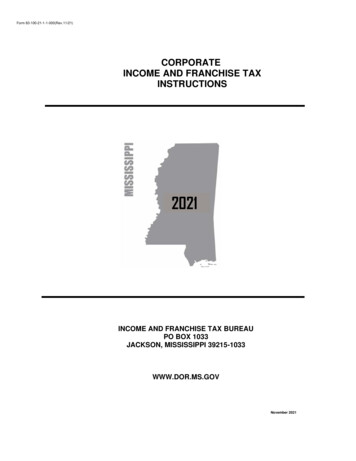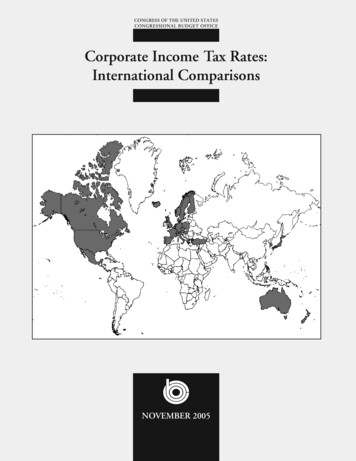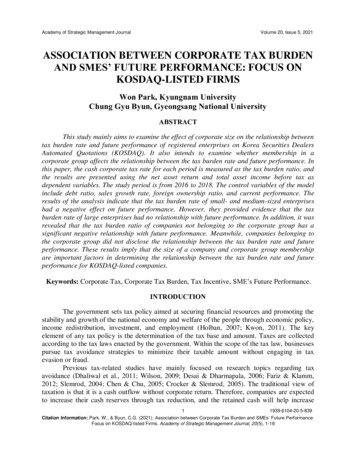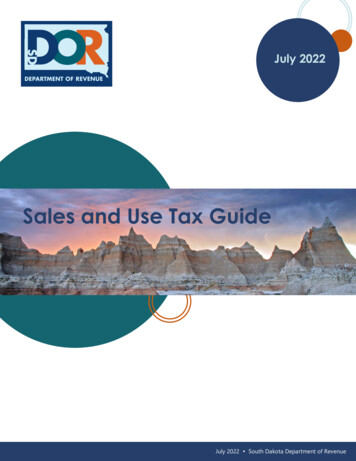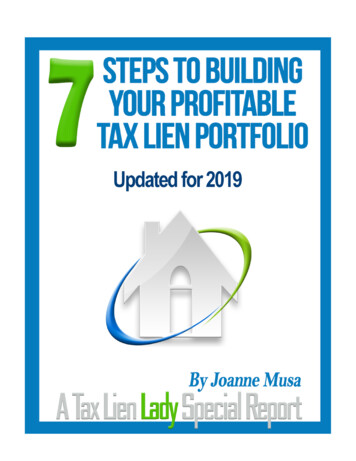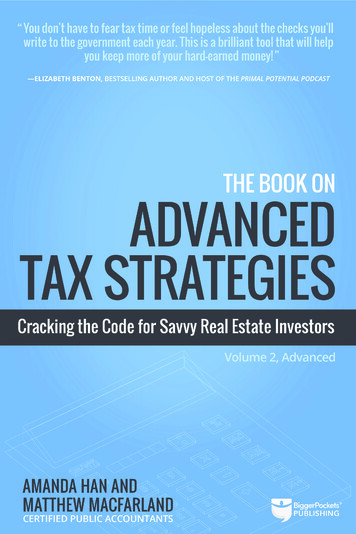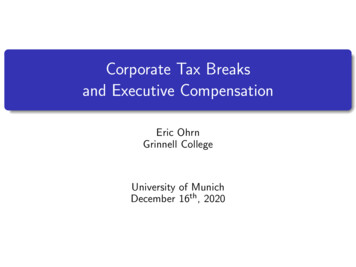
Transcription
Corporate Tax Breaksand Executive CompensationEric OhrnGrinnell CollegeUniversity of MunichDecember 16th , 2020
MotivationOver the past 30 years, there has been a substantial rise in CEO and executive compensationaround the world.The rise has been particularly spectacular at publicly traded US firms.From Frydman and Jenter (2010):1980–2010: 9x increase in CEO pay, 5x increase in pay for other top executives
MotivationThis rise in CEO and executive compensation has been disproportionate relative to wages,GDP, and firm value.The disconnect suggests a connection to the well-documented increase in US incomeinequality (Piketty, Saez and Zucman (2017), Smith, Zidar, Zwick et al. (2020)).
MotivationMeanwhile.In the presence of increasingpretax corporate profits in theUS (FRED),Effective corporate tax rates havesignificantly decreased (Dyreng,Hanlon, Maydew and Thornock(2017)).
IntroductionThese trends motivate an obvious and important, but unaddressed question:Do corporate tax breaks affect executive compensation?. and perhaps income inequality?Corporate tax breaks mechanically increase after-tax revenues / cash flows.After-tax revenues can be used to increase executive compensation via eitheran efficient market for managerial talentor rent capture by executives.Especially important for policy makers who, ostensibly, design corporate tax breaks to induce adesired behavior (i.e. capital investment, green energies, hiring). rather than to pad the pockets of executives.Answers to this question are also timely as the Tax Cuts and Jobs Act of 2017 has acceleratedthe decreasing effective corporate tax rate trend in the US and increased tax rate competitionworldwide.
IntroductionIn this study, I address these questions usingquasi-experimental variation in two recent US federal corporate tax expenditures(“breaks”)modified difference-in-differences frameworkto measure the effect of corporate taxation on the compensation packages of executives at large,publicly traded corporations.Headline Findings: Corporate tax breaks increase executive compensation1a one percentage point decrease in the present value cost of new investments due to bonusdepreciation increases executive compensation by 4.4%2a one percentage point reduction in effective corporate income tax rates due to theDomestic Production Activities Deduction (DPAD) increases pay by 3.3%These estimates imply that at a large publicly traded firms, every dollar of cash flows generatedby the tax breaks increases the compensation of the firm’s five highest paid executives by 16to 18 cents.
The Tax Breaks
Bonus DepreciationTypically, MACRS defines the allowabledeductions generated by a new capitalexpenditure in each yearLonger-lived assets benefit most from thepolicy industries that invest inlonger-lived assets, on average, benefitmore from the policyZwick and Mahon (2017): 50% bonus 2.73% decreases in PV cost of investments604020Decreases the present value cost ofinvestment by giving firms cash now asopposed to later0Bonus depreciation allows a “bonus”percentage of investment costs to bededucted from taxable income in the firstyear80100Figure: Bonus Depreciation (%) over time19982000200220042006200820102012Notes: This figure shows statutory bonus depreciation rates during the years1998–2012.Bonus Example
DPADBenefit is larger for firms that derive ahigher percentage of income frommanufacturing activitiesOhrn (2018): on average, 9% DPAD 1.43 percentage point reduction oneffective CIT rate1020At maximum 9% rate, DPAD decreasesthe effective corporate income tax rate by3.15 percentage points for a 100%domestic manufacturing firm46Percentage increased from 3 to 6 to 9%during the years 2005–2009Figure: DPAD Rate (%) over time8DPAD allows firms to deduct a percentageof income derived from domesticmanufacturing activities from their : This figure shows statutory DPAD rates during the years 1998–2012.
Tax Breaks LegislationBonus DepreciationFrom 2002–2012, bonus depreciation was part of 8 different pieces of legislationEnacted in piece-meal, usually one year extenders, sometimes retroactiveAlways some uncertainty regarding continuationFirms can benefit even when in tax loss positions increases NOLsDPADReplaced a different policy, the ETIEnacted as part of AJCA 2004 with the proposed phase-in schedule that was followed insubsequent yearsPredictable increases in the DPAD deduction rate, more believable after 2005, 2007Limited by taxable income so no benefit to loss making firms
Estimation Strategy and Data
Measuring the Tax BreaksBonus DepreciationI follow Zwick and Mahon (2017) and combinean industry-level measure of the average depreciation life of new capital assets (fromadministrative tax data) andchanges in the generosity of bonus depreciation over time to createBONUS percentage point decrease in the PV price of new investmentDPADI follow Ohrn (2018) and combineIndustry-by-size percentage of income that qualifies for the deduction from IRS SOIfirm-level taxable status (taxable income 0)variation in the generosity of the DPAD over time to createDPAD percentage point reduction in effective CIT due to the DPAD
Bonus Depreciation0246Figure: Quasi-experimental Variation in Bonus Depreciation (%) over time19982001BONUS Top Quartile200520082012BONUS Botton QuartileNotes: This figure displays the percentage point reduction in capital investment costs due to bonus depreciation for the quartile of firms with the longest taxlives relative to firms with the shortest tax lives during the years 1998–2012.
DPAD0.511.52Figure: Quasi-experimental Variation in the DPAD (%) over time19982005DPAD Top Quartile200720092012DPAD Botton QuartileNotes: This figure displays the percentage point reduction in the effective corporate income tax rate due to the DPAD for firms in the top quartile of DPADrelative to firms in the bottom quartile of DPAD during the years 1998–2012.
Data SourcesExecutive Compensation DataExecutive compensation data is taken from the Compustat Execucomp databaseSample is limited to the top five highest paid executives at each firm in each yearExecucomp includes gender, some data on executive positions, and can be used to constructan experience variable (number of years in Execucomp)Other Data SourcesFirm financial statement data from COMPUSTAT in order to control for firm-leveldeterminants of executive pay13f Institutional Holdings data from Reuters to construct the percentage of shares held bythe largest institutional investorGovernance score based on Risk Metrics data following Bebchuk, Cohen and Ferrell (2009)Final Data Sample15 years; 1998–20124 years before bonus depreciation enacted, 4 years after DPAD fully-phased in29,865 executives2,798 firmsDescriptive Statistics
Estimation StrategyModified difference-in-differences empirical strategy:Ln(Total Comp)i,t β0 β1 [BONUSj,t 1 ] β2 [DPADi,t 1 ] γXi,f,t 1 νt µf εi,tLn(Total Comp): natural log of total compensation awarded to five highest paid atExecucomp firmsX: controls which vary by specification and can include other tax policies (ETI), executiveexperience and gender, firm size, ROA, and R&D, and 2001 or 2004 terciles of firm size,ROA, market-to-book, and pre-period compensation growth interacted with year indicatorsνt µf : year and firm fixed effectsI follow the executive compensation literature in lagging tax policies and firm controlsStandard errors are clustered at the industry-level (Bertrand, Duflo and Mullainathan (2004),Cameron and Miller (2015))I will perform a series of dynamic analyses in which I will replace the temporal variation eachpolicy’s generosity with a series of year indicators to measure how differences between themost and least treated units evolve over time
Outcome VariableTotal Compensation Awardedcomprised of an executives salary, bonus, other annual (non-incentive) compensation, totalvalue of restricted stock granted, total value of stock options granted (calculated using theBlack Scholes formula), long-term incentive payouts, and all other compensation“awarded”: options valued at granting date priceFigure: Structure of Executive Compensation for Analysis SampleCompensation Levels ( 1,000s) by Category00201000402000603000804000100Percent of Total Comp by Category1998200020022004OptionsSalaryOtherFiscal Year2006200820102012199820002002StockBonus LTI PlansNotes: The left panel of this figure shows theaverage Total Comp fairly stable over the periodincreasing use of restricted stock relative to options after 20002004Fiscal YearOptionsSalaryOther2006StockBonus LTIP200820102012
Baseline Results
Baseline EstimatesTable: Effect of Tax Breaks on Executive Compensation; Baseline AnalysisLagged BONUSLagged DPADYear FEFirm FETax ControlsExec ControlsFize Size ControlROA, RD ControlsObservations(1)Ln(Comp)0.0300 (0.0122)(2)Ln(Comp)0.0301 (0.0123)(3)Ln(Comp)0.0381 (0.0127)(4)Ln(Comp)0.0443 (0.0117)(5)Ln(Comp)0.0435 (0.0114)0.0387 (0.0127)XX0.0390 (0.0117)XXX0.0390 (0.0116)XXXX0.0333 (0.0127)XXXXX1272561272561272561272560.0324 (0.0123)XXXXXX127256Notes: This table presents coefficient estimates of the effect of Lagged BONUS and Lagged DPAD on executive compensation. The outcome variable in allspecifications is the log of Total Comp Awarded. All specifications include firm and year fixed effects. Specifications (2)–(5) control for the ETI.Specifications (3)–(5) include executive controls for gender and experience. Specifications (4) and (5) include time-varying firm-level controls for lagged logassets. Specification (5) includes time-varying firm-level controls for lagged ROA and lagged R&D expenditure dividend by sales. Standard errors arepresented in parentheses and are clustered at the four-digit NAICS level. * p 0.10, ** p 0.05, *** p 0.01
Baseline EstimatesTable: Effect of Tax Breaks on Executive Compensation; Baseline AnalysisLagged BONUSLagged DPADYear FEFirm FETax ControlsExec ControlsFize Size ControlROA, RD ControlsObservations(1)Ln(Comp)0.0300 (0.0122)(2)Ln(Comp)0.0301 (0.0123)(3)Ln(Comp)0.0381 (0.0127)(4)Ln(Comp)0.0443 (0.0117)(5)Ln(Comp)0.0435 (0.0114)0.0387 (0.0127)XX0.0390 (0.0117)XXX0.0390 (0.0116)XXXX0.0333 (0.0127)XXXXX1272561272561272561272560.0324 (0.0123)XXXXXX127256Notes: This table presents coefficient estimates of the effect of Lagged BONUS and Lagged DPAD on executive compensation. The outcome variable in allspecifications is the log of Total Comp Awarded. All specifications include firm and year fixed effects. Specifications (2)–(5) control for the ETI.Specifications (3)–(5) include executive controls for gender and experience. Specifications (4) and (5) include time-varying firm-level controls for lagged logassets. Specification (5) includes time-varying firm-level controls for lagged ROA and lagged R&D expenditure dividend by sales. Standard errors arepresented in parentheses and are clustered at the four-digit NAICS level. * p 0.10, ** p 0.05, *** p 0.01
Internal Validity Checks
Identification Strategy ScrutinyKey Threat to Identification:Other industry-by-time shocks affecting executive compensation covary with the policies.I address this threat by1examining dynamic effects of the policies2showing results are robust to a number of modeling specifications designed to address keythreats3performing two placebo tests; one for each policyDPAD Placebo: QPAI% Non-taxableBONUS Placebo: Long-duration industries that invest in 5 more ineligble as eligiblecapital
Dynamic Difference-in-DifferencesFigure: Effect of Bonus Depreciation on Executive CompensationComp Trend Coefficients, First Episode07.27.3.057.47.5.17.67.7.15BONUS Coefficient-.051998199820022008201220022005Fiscal Year30% Bonus50% Bonus 2High BONUS Industries2008201250% Bonus 1100% BonusLow BONUS IndustriesNotes: This figure presents a graphical dynamic analysis of the effect of bonus depreciation on executive compensation. β1998 – β2012 with β2001normalized to 0. Vertical bands represent 95% confidence intervals. Panel (b) presents the trend in the Log of Total Comp Awarded and the trend plus thecoefficients. These lines represent trends in average executive compensation for Low BONUS (the trend) and High BONUS (the trend plus coefficients)industries.
Dynamic Difference-in-DifferencesFigure: Effect of the DPAD on Executive CompensationComp Trend DPAD Coefficient7.207.37.4.057.57.6.1DPAD 042006Fiscal Year3% DPAD9% DPADLow DPAD Industries2008201020126% DPADHigh DPAD IndustriesNotes: This figure presents a graphical dynamic analysis of the effect of the DPAD on executive compensation. β1998 – β2012 with β2004 normalizedto 0. Vertical bands represent 95% confidence intervals. Panel (b) presents the trend in the Log of Total Comp Awarded and the trend plus the coefficients.These lines represent trends in average executive compensation for Low DPAD (the trend) and HighDPAD (the trend plus coefficients) industries.
Dynamic Difference-in-Differences-.050.05.1.15Figure: Effect of the BONUS on Executive Compensation; Robustness199820022005No Firm Controls2001 Char. x Year Controls200820121999-2001 Comp GrowthNotes: This figure presents a graphical dynamic analysis of the effect of bonus depreciation on executive compensation. β1998 – β2012 with β2001normalized to 0. Vertical bands represent 95% confidence intervals. Panel (b) presents the trend in the Log of Total Comp Awarded and the trend plus thecoefficients. These lines represent trends in average executive compensation for Low BONUS (the trend) and High BONUS (the trend plus coefficients)industries.
Dynamic Difference-in-Differences-.050.05.1.15Figure: Effect of the BONUS on Executive Compensation; Robustness199820022005No Firm Controls2001 Char. x Year Controls200820121999-2001 Comp GrowthNotes: This figure presents a graphical dynamic analysis of the effect of bonus depreciation on executive compensation. β1998 – β2012 with β2001normalized to 0. Vertical bands represent 95% confidence intervals. Panel (b) presents the trend in the Log of Total Comp Awarded and the trend plus thecoefficients. These lines represent trends in average executive compensation for Low BONUS (the trend) and High BONUS (the trend plus coefficients)industries.
Dynamic Difference-in-Differences-.050.05.1.15Figure: Effect of the BONUS on Executive Compensation; Robustness199820022005No Firm Controls2001 Char. x Year Controls200820121999-2001 Comp GrowthNotes: This figure presents a graphical dynamic analysis of the effect of bonus depreciation on executive compensation. β1998 – β2012 with β2001normalized to 0. Vertical bands represent 95% confidence intervals. Panel (b) presents the trend in the Log of Total Comp Awarded and the trend plus thecoefficients. These lines represent trends in average executive compensation for Low BONUS (the trend) and High BONUS (the trend plus coefficients)industries.
Dynamic Difference-in-Differences-.050.05.1.15Figure: Effect of the BONUS on Executive Compensation; Robustness199820022005No Firm Controls2001 Char. x Year Controls200820121999-2001 Comp GrowthNotes: This figure presents a graphical dynamic analysis of the effect of the DPAD on executive compensation. Panel (a) plots coefficients β1998 –β2012 after the average coefficient from years 1998–2004 has been normalized to zero. Vertical bands represent 90% confidence intervals. Panel (b)presents the trend in the Log of Total Comp Awarded and the trend plus the coefficients. These lines represent trends in average executive compensation forLow DPAD (the trend) and High DPAD (the trend plus coefficients) industries.
Dynamic Difference-in-Differences-.05 -.0250.025.05.075.1.125Figure: Effect of the DPAD on Executive Compensation; Robustness19982002No Firm Controls2004 Char. x Year Controls2007200920122001-2004 Comp GrowthNotes: This figure presents a graphical dynamic analysis of the effect of the DPAD on executive compensation. β1998 – β2012 with β2004 normalizedto 0. Vertical bands represent 95% confidence intervals. Panel (b) presents the trend in the Log of Total Comp Awarded and the trend plus the coefficients.These lines represent trends in average executive compensation for Low DPAD (the trend) and HighDPAD (the trend plus coefficients) industries.
Dynamic Difference-in-Differences-.05 -.0250.025.05.075.1.125Figure: Effect of the DPAD on Executive Compensation; Robustness199820022005No Firm Controls2004 Char. x Year Controls200820122001-2004 Comp GrowthNotes: This figure presents a graphical dynamic analysis of the effect of the DPAD on executive compensation. β1998 – β2012 with β2004 normalizedto 0. Vertical bands represent 95% confidence intervals. Panel (b) presents the trend in the Log of Total Comp Awarded and the trend plus the coefficients.These lines represent trends in average executive compensation for Low DPAD (the trend) and HighDPAD (the trend plus coefficients) industries.
Dynamic Difference-in-Differences-.05 -.0250.025.05.075.1.125Figure: Effect of the DPAD on Executive Compensation; Robustness199820022005No Firm Controls2004 Char. x Year Controls200820122001-2004 Comp GrowthNotes: This figure presents a graphical dynamic analysis of the effect of the DPAD on executive compensation. β1998 – β2012 with β2004 normalizedto 0. Vertical bands represent 95% confidence intervals. Panel (b) presents the trend in the Log of Total Comp Awarded and the trend plus the coefficients.These lines represent trends in average executive compensation for Low DPAD (the trend) and HighDPAD (the trend plus coefficients) industries.
Dynamic Difference-in-Differences-.05 -.0250.025.05.075.1.125Figure: Effect of the DPAD on Executive Compensation; Robustness199820022005No Firm Controls2004 Char. x Year Controls200820122001-2004 Comp GrowthNotes: This figure presents a graphical dynamic analysis of the effect of the DPAD on executive compensation. β1998 – β2012 with β2004 normalizedto 0. Vertical bands represent 95% confidence intervals. Panel (b) presents the trend in the Log of Total Comp Awarded and the trend plus the coefficients.These lines represent trends in average executive compensation for Low DPAD (the trend) and HighDPAD (the trend plus coefficients) industries.
Robustness of Baseline Estimates to Alternative SpecificationsFigure: Robustness to Alternative SpecificationsBONUSDPADBaselineBaselinePre-period Growth x Year FEPre-period Growth x Year FE2001 Char. x Year FE2004 Char. x Year FEDec. Fiscal Year FirmsDec. Fiscal Year FirmsDomestic FirmsDomestic FirmsWinsorized Tax VarsWinsorized Tax Vars0.02.04.06.08-.050.05.1.15Notes: Panels (A) and (B) show the robustness of of the baseline estimates of Lagged BONUS and Lagged DPAD to alternative specifications. The first rowdisplays baseline estimates. The second row includes terciles of Log(Total Comp) growth during the preperiod interacted with year fixed effects. The thirdrow includes indicators for terciles of lagged ROA, lagged log firm size, and lagged log Market-to-Book interacted with year indicators. The fourth columnlimits the sample to firms with no pre-tax foreign income. The fifth row includes tax breaks winsorized at the 3rd and 97th percentiles in each year.Alt. Spec. Table
Robustness of Baseline Estimates to Alternative SpecificationsFigure: Robustness to Alternative SpecificationsBONUSDPADBaselineBaselinePre-period Growth x Year FEPre-period Growth x Year FE2001 Char. x Year FE2004 Char. x Year FEDec. Fiscal Year FirmsDec. Fiscal Year FirmsDomestic FirmsDomestic FirmsWinsorized Tax VarsWinsorized Tax Vars0.02.04.06.08-.050.05.1.15Notes: Panels (A) and (B) show the robustness of of the baseline estimates of Lagged BONUS and Lagged DPAD to alternative specifications. The first rowdisplays baseline estimates. The second row includes terciles of Log(Total Comp) growth during the preperiod interacted with year fixed effects. The thirdrow includes indicators for terciles of lagged ROA, lagged log firm size, and lagged log Market-to-Book interacted with year indicators. The fourth columnlimits the sample to firms with no pre-tax foreign income. The fifth row includes tax breaks winsorized at the 3rd and 97th percentiles in each year.Alt. Spec. Table
Robustness of Baseline Estimates to Alternative SpecificationsFigure: Robustness to Alternative SpecificationsBONUSDPADBaselineBaselinePre-period Growth x Year FEPre-period Growth x Year FE2001 Char. x Year FE2004 Char. x Year FEDec. Fiscal Year FirmsDec. Fiscal Year FirmsDomestic FirmsDomestic FirmsWinsorized Tax VarsWinsorized Tax Vars0.02.04.06.08-.050.05.1.15Notes: Panels (A) and (B) show the robustness of of the baseline estimates of Lagged BONUS and Lagged DPAD to alternative specifications. The first rowdisplays baseline estimates. The second row includes terciles of Log(Total Comp) growth during the preperiod interacted with year fixed effects. The thirdrow includes indicators for terciles of lagged ROA, lagged log firm size, and lagged log Market-to-Book interacted with year indicators. The fourth columnlimits the sample to firms with no pre-tax foreign income. The fifth row includes tax breaks winsorized at the 3rd and 97th percentiles in each year.Alt. Spec. Table
BinscatterFigure: Binscatter Plots, Effects of Tax Breaks on Executive CompensationDPAD Binscatter7.387.47.4Log(Total Compensation)7.427.447.46Log(Total Compensation)7.427.447.467.487.57.48BONUS Binscatter0.51Lagged BONUS1.52-.50.5Lagged DPAD11.5Notes: This figure presents binscatter plots showing the effect of each tax break on Log(Total Comp). Black lines are linear projections based on theunderlying data. Binscatter plots are conditional means of the outcome on bins of the tax breaks after conditioning on all controls. Both models include theother tax break, firm and year fixed effects, controls for executive gender and experience and lagged log of firm size.
Robustness of Baseline Estimates to Alternative SpecificationsFigure: Robustness to Alternative SpecificationsBONUSDPADBaselineBaselinePre-period Growth x Year FEPre-period Growth x Year FE2001 Char. x Year FE2004 Char. x Year FEDec. Fiscal Year FirmsDec. Fiscal Year FirmsDomestic FirmsDomestic FirmsWinsorized Tax VarsWinsorized Tax Vars0.02.04.06.08-.050.05.1.15Notes: Panels (A) and (B) show the robustness of of the baseline estimates of Lagged BONUS and Lagged DPAD to alternative specifications. The first rowdisplays baseline estimates. The second row includes terciles of Log(Total Comp) growth during the preperiod interacted with year fixed effects. The thirdrow includes indicators for terciles of lagged ROA, lagged log firm size, and lagged log Market-to-Book interacted with year indicators. The fourth columnlimits the sample to firms with no pre-tax foreign income. The fifth row includes tax breaks winsorized at the 3rd and 97th percentiles in each year.Alt. Spec. Table
Placebo TestsBonus Depreciation Placeboidentify “long-lived industries” who investment 5x more in ineligible than eligible capitalIP and structuresScale variable placebo such that these “long-lived” placebo industries receive average bonusdepreciation treamentDPAD PlaceboInteract industry-by-size variation in the DPAD with an indicator for loss-makingEstimate the effect of loss making firms generating 100% of income via domesticmanufacturing activites against loss-making firms in 0% domestic manufacturing firms
Placebo TestsTable: Effect of Placebo Tax Breaks on Executive CompensationLagged BONUS(1)Ln(Comp)0.0427 (0.0121)-0.0268 (0.0143)Lagged BONUS PlaceboYear FEFirm FEPreferred ControlsObservations(3)Ln(Comp)0.0342 (0.0130)Lagged DPADLagged DPAD Placebo(2)Ln(Comp)XXX127256-0.0287 27256Notes: This table presents coefficient estimates of the effect of Lagged BONUS, Lagged DPAD, and Lagged BONUS Placebo and Lagged BONUS placeboon the log of Total Comp Awarded. All specifications include firm and year fixed effects, executive controls for, gender and experience and lagged log firmsize. Standard errors are presented in parentheses and are clustered at the four-digit NAICS level. * p 0.10, ** p 0.05, *** p 0.01
Placebo TestsFigure: Dynamic DD Placebo DPAD199820022008201219982005200720092012Bonus depreciationplacebo test shows increases in compensation in industries that invest primarily in“long-lived” but ineligible goods do not coincide with bonus depreciation episodes growth in executive compensation in “long-lived” industries per se is not responsible forestimated effects on bonus depreciationDPADplacebo test show no increase in compensation for loss-making firms benefiting from DPAD compensation is driven by cash flow effects of policy
Exploring Mechanisms
Exploring MechanismsPurely Mechanical Effects?Break down effects by compensation type (more or less likely to be mechanically influenced)Control for contemporary and lagged ROA and stock return (mechanical determinants)More firepower in the market for executive talent?Estimate whether effects are larger for new hiresRent Capture?Estimate whether effects are concentrated among powerful shareholdersCEOs, executives also on the board of directorsEstimate whether effects are mitigated in well-governed firms1 firms with less “entrenched” executives (Bebchuk, Cohen and Ferrell (2009))2 firms with powerful principals: large institutional shareholders (Chetty and Saez (2005))
Compensation StructureTable: Effect of Tax Breaks by and on Compensation StructureLagged BONUSLagged DPADMech. ControlsObservations(1)Ln(Current)0.0377 al0.00140(0.00642)(4)Ln(Current)0.0375 al-0.000363(0.00676)-0.00300(0.00975)0.0578 (0.0235)-0.0136 50.0444 (0.0243)X121008-0.0118 (0.00465)X122535Notes: This table presents coefficient estimates from specifications similar to the preferred baseline with alternative outcomes. The outcome variable incolumns (1) and (4) is the log of Total Current Compensation (salary plus bonus). The outcome variable in columns (2) and (5) is the log of TotalNon-Current Compensation (total compensation awarded minus salary plus bonus). The outcome variable in columns (3) and (6) is the ratio of TotalCurrent Compensation to Total Compensation Awarded. All specifications include firm and year fixed effects, controls for executive experience and gender,and the log of firm size. Specifications (4)–(6) also include controls for ROA, lagged ROA, stock return, and lagged stock return. Standard errors arepresented in parentheses and are clustered at the four-digit naics level. * p 0.10, ** p 0.05, *** p 0.01Bonus affects salary and bonus comp, DPAD affects stock-based compEffects consistent with legislationbonus: piecemeal, cash now vs. laterDPAD: planned, generates future benefitIncluding Mech. Controls (ROA, Stock Return, and their lags) effects are not purely mechanical
Executive Position HeterogeneityTable: Heterogeneity in the Effect of Tax Breaks by Executive Position(1)Ln(Comp)0.0457 (0.0155)(2)Ln(Comp)0.0390 (0.0134)(3)Ln(Comp)0.0424 (0.0161)(4)Ln(Comp)0.0250 (0.0128)Lagged DPAD0.0335 (0.0174)0.0318 (0.0128)0.0343 (0.0161)0.0382 (0.0103)L.BONUS New Hire-0.00535(0.00492)L.DPAD New Hire0.00109(0.0172)Lagged BONUSL.BONUS CEO0.0135 (0.00550)0.00820(0.00637)L.DPAD CEO0.0135(0.0194)0.00594(0.0191)L.BONUS Director0.0102(0.00746)0.0160 (0.00842)L.DPAD Director-0.0246 256127256
Governance Level HeterogeneityTable: Heterogeneity in the Effect of Tax Breaks by Governance Level(1)Ln(Comp)0.0411 (0.0138)(2)Ln(Comp)0.0473 (0.0110)(3)Ln(Comp)0.0448 (0.0144)(4)Ln(Comp)0.0407 (0.0136)Lagged DPAD0.0619 (0.0193)0.0467 (0.0170)0.0781 (0.0284)0.0486 (0.0202)L.BONUS Large Holder-0.00936(0.00621)-0.0132(0.00906)-0.0554 (0.0169)-0.0390 (0.0230)Lagged BONUSL.DPAD Large HolderL.BONUS Strong Gov-0.0113(0.00708)-0.0193 (0.00787)L.DPAD Strong Gov-0.0298 (0.0172)-0.0358(0.0223)BONUS Combined Gov 33-0.0232 (0.0120)L.DPAD Combined Gov 33-0.0350(0.0349)36383Observations681345942336383
Discussion and Implications
ImplicationsImplied MagnitudesCalculate how much of each dollar generated by tax breaks go to top executivesRelates to incidence of corporate taxes on wages(Harberger (1962) . Fuest, Peichl and Siegloch (2018) .)Most Related FindingsIn what ways are these findings similar and different to the most related papers.Implications for Determinants of Executive PayShareholder value view vs. rent extractionImplications for Income InequalityEstimate of effects of tax breaks on average workersCompare estimates to assess within-firm inequality implications
Implied MagnitudesBonus DepreciationA one percentage point decrease in PV cost of investment via bonus depreciation raisescompensation of the top five highest paid executives by 4.43% or by 593,000.Two ways to measure the cash generated by bonus depreciationPresent Value Cash Flows: Average firm in sample does 314 million in investment per year.A one percentage point reduction in present value costs is equivalent to a 3.14 million present value tax break (this is the correct way to think aboutthe real benefits of the policy).Current Cash Flows: 43% average bonus x 314 million x taxable 75% of the time 101million in cash flow generated by bonus depreciation for the average firmeach yearOne conclusion: increase in top 5 executive compensation is only about 0.6% of current cashflows generated by bonus depreciation.A different conclusion: because the policy simply accelerates the c
Executive Compensation Data Executive compensation data is taken from the Compustat Execucomp database Sample is limited to the top ve highest paid executives at each rm in each year Execucomp includes gender, some data on executive positions, and can be used to construct an experience variable (number of years in Execucomp) Other Data Sources
